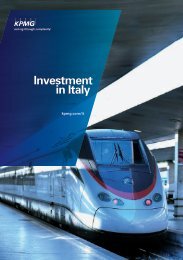Innovation Canada: A Call to Action
Innovation Canada: A Call to Action
Innovation Canada: A Call to Action
Create successful ePaper yourself
Turn your PDF publications into a flip-book with our unique Google optimized e-Paper software.
The Context of the Review<strong>Innovation</strong> andBusiness StrategyWhat influences the decision of an enterprise <strong>to</strong>make innovation the core of its competitivestrategy? What leads some firms and not others<strong>to</strong> look constantly for ways <strong>to</strong> create or enternew markets, <strong>to</strong> develop new or improvedproducts, <strong>to</strong> <strong>to</strong>lerate the disruption ofintroducing more efficient processes andorganization, and <strong>to</strong> take the (calculated) risksthat innovation always involves? Although thereis no consensus on all the fac<strong>to</strong>rs that come in<strong>to</strong>play, the Panel adopted, as a workinghypothesis, a modified version of the logicmodel developed by the CCA’s Expert Panel onBusiness <strong>Innovation</strong> (Figure 2.4). According <strong>to</strong>this view, a firm’s decision on whether (or not)<strong>to</strong> adopt an innovation-based strategy dependsprincipally on the following six broad fac<strong>to</strong>rs,the relative importance of which will vary withthe firm’s specific circumstances.Market opportunities. A successful businessstrategy depends, first and foremost, on anunderstanding of the needs of the cus<strong>to</strong>merand the related identification of marke<strong>to</strong>pportunity. Business strategies focussed oninnovation constantly seek better ways <strong>to</strong>meet existing cus<strong>to</strong>mer needs — for example,the overnight courier — or ways <strong>to</strong> stimulateentirely new sources of demand — forexample, the smart phone.Structural characteristics. Is the firm in asec<strong>to</strong>r that is traditionally innovation oriented,such as biotech or computers, or is it involvedin the provision of a more standard produc<strong>to</strong>r service? Is the firm a subsidiary of a foreigncompany that conducts most R&D abroad?Does the firm sell its product <strong>to</strong> the end-user,or does it provide an intermediate input —for example, lightly processed resources —in a global value chain?Competitive intensity. Must the firmcontinuously innovate <strong>to</strong> survive because itprovides a product or service driven byevolving cus<strong>to</strong>mer tastes? Is the firm active ina market (domestic or foreign) that is exposed<strong>to</strong> intense global competition and musttherefore innovate <strong>to</strong> survive and prosper?Climate for new ventures. Is the firm par<strong>to</strong>f an innovation cluster in which there is areadily available supply of sophisticatedventure financing, cutting-edge knowledge,highly skilled graduates and other firms withcomplementary expertise?Public policies. Are legal and regula<strong>to</strong>ryframeworks and policies — for example, inareas such as competition, corporate taxation,bankruptcy and intellectual property —conducive, or not, <strong>to</strong> business innovation?Business ambition. What is the corporateculture of the firm? To what extent is it riskaverse? To what extent is it dedicated <strong>to</strong>expansion?It is beyond the scope of this review <strong>to</strong> addressall of these fac<strong>to</strong>rs. The Panel’s mandate isfocussed on federal government supportprograms for R&D that is undertaken bybusiness or that is commercially oriented. Theeffectiveness of that support will neverthelessdepend ultimately on the extent <strong>to</strong> whichbusinesses in <strong>Canada</strong> are motivated <strong>to</strong> adoptinnovation-based business strategies thatrequire R&D <strong>to</strong> be performed. In this regard,competitive intensity provides the strongestmotivation overall. In business, the “necessity”created by competition is often the “mother” ofinnovation. The Panel’s advice in this review willtherefore have much more impact on <strong>Canada</strong>’seconomic performance if it is complemented bya suite of policies <strong>to</strong> foster competition asrecommended by the Competition Policy ReviewPanel (2008), also known as the “Wilson panel”(see Annex B). That panel pointed <strong>to</strong> severalsec<strong>to</strong>rs that remain buffered from competitionby various regulations, including restrictive2-9
















